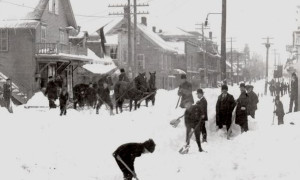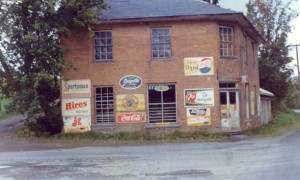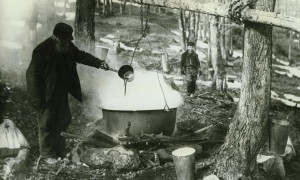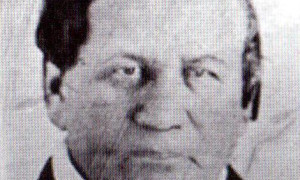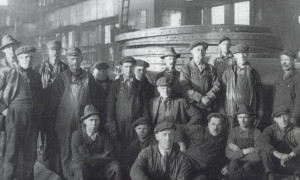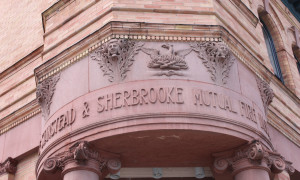Articles
--October 21, 2016.
1. Which of the following towns is named after a Catholic cleric?
a) Racine
b) Bishopton
c) Valcourt
d) All of the above
2. Which of the following ski resorts is named after the township in which it is located?
a) Orford
b) Bromont
c) Sutton
d) All of the above
e) None of the above
3. Which of the following was NOT one of the original Eastern Townships?
a) Hatley
b) Bolton
c) Magog
d) Bury
e) All of the above
Benjamin Cate Howard (1865-1923) was born with a deep and solid Eastern Townships’ heritage - his grandparents from his father’s side had been Irish immigrants arriving in the Townships in the early 1820s, and a set of great grandparents from his mother’s side had been part of the Marlow pioneers in Stanstead, arriving from New Hampshire circa 1800. As it was, Ben Howard was born the second son to a farming family on what was known as the Howard Farm, Apple Grove, which was an area just a few miles northwest from where the old Marlow Settlement had been located - present day, Marlington.
The Richmond County Historical Society (RCHS) was formed in 1962.
As part of our 50th anniversary celebrations, we have presented some photos and information from the past.
The Mills during the period of the French, British and Eastern Townships
The Woods (Burt) Store was located at the corner of Route 243 and Cemetery Road in Melbourne, Quebec.
In 1887 the Upper Melbourne Post office, with H. L. Burt as Postmaster, was one of sixteen Richmond subscribers of the Bell Telephone Company of Canada.
Sir Casimir Gzowski, great-grandfather of Canadian broadcaster Peter Gzowski, and engineer for the St. Lawrence & Atlantic Railway, forerunner to the Grand Trunk, built this trestle over the St. Francis River at the north end of Richmond in 1852.
(Photo courtesy of the Richmond County Historical Society Archives)
As I entered the Fort Chambly, old ghosts of people seemed to appear. I see some putting cannonballs in cannons and then light the wick. The sound is awfully loud! A tour guide then tells me about the history of the Fort Chambly…
Fort Chambly was fist built in 1665. There were 4 forts. The first one was in wood. It was unfortunately too old so, they needed to replace it. They replaced it by another one in wood. It then accidentally burnt. Because the wood fort couldn’t protect itself from cannonballs and other explosives, they replaced the wood fort by a stone fort.
I would like to write about my ancestor William Thomas. William was born in England in 1784 and joined the army. He was in the 81st Regiment of Foot. The regiment was called “the Loyal Lincoln Volunteers”. He was sent to Canada to fight the war in 1812 called the Napoleon wars. He was sent to Quebec City and took a boat all the way to Hull to protect Lower Canada against the Americans.
In the month of May, the apples blossom. In fall, the apples are ripe and ready to be picked. Apple growing has been a main industry for Frelighsburg since 1930, but apples have been grown in the area for a long time.
Frelighsburg is a good place to grow apples because of the gentile hills, the soils, and the pattern of the winds will blow in the area. Farmers began to change their farms to apple orchards.
Adelard Godbout, who was once the premier of Quebec, had an orchard in the Frelighsburg area.
George was born in Napierville, in the province of Quebec, on September 29, 1836. His father was of Irish descent, and he was a farmer and a mill owner. The early days of George’s life was spent on the family farm and in his father’s mill.
In the 1800s railways were needed in the Eastern Townships to get to raw materials, for fast travel, the growth of businesses, and to fill in the desire to build more railway lines. In the past most people didn’t have cars to travel with or trucks to carry materials. Railways met this need.
The St. Francis College (1854-1898) played a prominent role on the education scene in Quebec.
Did you know that maple syrup is the oldest agricultural product in Quebec? It all began with the Indigenous peoples who called it “Sweet Water.” When spring returned and the maple sap was running the Indigenous peoples offered the boiled thickened syrup as a sacrifice to the Great Spirit. “Sugaring off” was largely a woman’s function in Iroquois communities. The men cut notches into tree trunks and small wooden troughs were stuck into the bark.
Religion and education were two of the primary necessities for immigrants, mostly from New England, who settled in the Hatley region following the opening of the Eastern Townships in 1792. in the late 1790s, several familes settled about a mile or so north of the present village of Hatley; amongst these was the family of Deacon Bond Little.
The Story of Sherbrooke's Ingersoll - Rand, commonly just called the Rand, is not only the history of a prolific industry, but a glimpse into the lives of the thousands of men and women who worked there. In Sherbrooke, almost everyone knows someone who worked in the sprawling west-end shops of the Rand.
Founded in Charleston (Hatley Village) in 1835, by a number of prominent Sherbrooke businessmen, including Samuel Brooks, C. F. H. Goodhue, Otis King, and others, the Stanstead and Sherbrooke Fire Insurance Company operated successfully for over a century and a half, making it one of the longest-running Eastern Townships companies.
On Thursday October 7, 1875, the readers of the Stanstead Journal read the following notice :
"DEATHS: Way -- At Way’s Mills, Q., Sept 22d, Daniel Way in the 83rd year of his age."
1) What is the former name of Magog?
a) Cherry River
b) The Outlet
c) Magog Mills
2) Which of the following is Magog’s oldest house?
a) The Bowen House
b) The Merry House
c) The Moore House
3) The outlet of Lake Memphremagog, located in Magog, is which of these rivers?
a) Cherry River
b) Magog River
c) Tomifobia River
4) Who was the first mayor of the village of Magog?
a) Alvin Moore
b) Erasmus Smith
c) L. A. Audet
1) b); 2) b) The Merry House, recently acquired by the city, was built in 1821; 3) b); 4) a); 5) b); 6) a); 7) c); 8) c); 9) b) This church was built as the Union Church in 1830; 10) a) The Park House was built by Horace Park in 1865, and destroyed by fire in 1905.
1) Which of the following is NOT a borough of the City of Sherbrooke?
a) Fleurimont
b) Waterville
c) Rock Forest
2) In which Sherbrooke borough may be found Uplands Heritage and Cultural Centre?
a) Vieux Sherbrooke
b) Lennoxville
c) Brompton
3) Which of the following was a former name of Sherbrooke?
a) Little Forks
b) Little Hyatt
c) Hyatt’s Mills
4) After whom is Sherbrooke named?
a) Sir John Coape Sherbrooke
b) Lord Dufferin of Sherbrooke
c) Lord Sherbrooke of Dufferin
